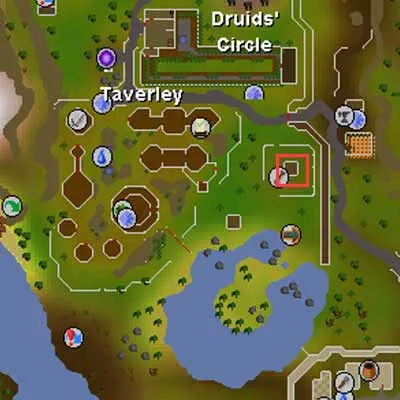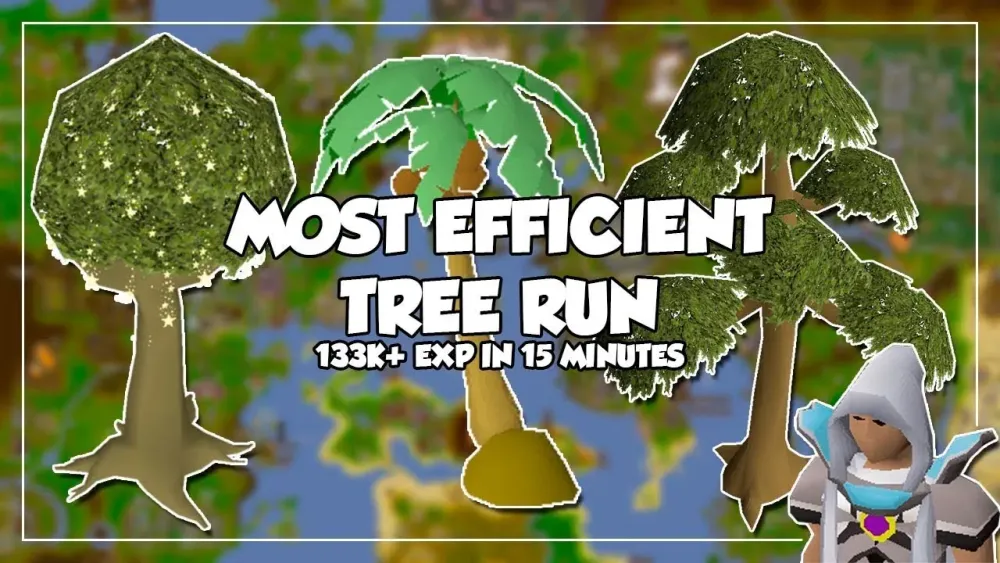Your cart is empty
Mastering Efficient Farm Runs in OSRS: Tips and Strategies

Farming in Old School RuneScape (OSRS) offers players a unique and rewarding experience, allowing them to cultivate crops, raise livestock, and gather resources. This skill not only contributes to your overall progression but also provides essential materials for crafting, potion-making, and other activities. Mastering efficient farm runs can significantly enhance your gameplay, save time, and maximize profit. In this guide, we will explore the core mechanics of farming in OSRS and provide strategies to optimize your farming runs.
Farming in OSRS revolves around the cultivation of crops and the management of patches. To begin farming, players must first acquire a spade and access various farming patches located throughout Gielinor. The patches can be divided into several categories, including allotment patches, herb patches, flower patches, and tree patches, each of which requires different seeds and has distinct growth cycles.
Each type of crop has its own growth time, with some taking only minutes while others may take several hours or even days. Players can check the growth status of their crops by inspecting the patch. Furthermore, crops can be affected by factors such as diseases and pests, which can hinder growth and yield. To prevent diseases, players can use compost, which increases the quality of the soil and improves crop yield. Super compost, made from a mix of regular compost and specific food items, is even more effective.
Farming experience is gained every time a seed is planted, when a crop is harvested, and by using certain items such as the Farming skill cape. Additionally, planting multiple seeds at once can provide a significant experience boost, making it essential to plan your runs effectively. Utilizing the right tools, such as the Farming Guild or the Farming Contract system, can help streamline your farming process and maximize profits.
Moreover, understanding the optimal times for farming is crucial. Players should align their farming runs with their play schedule, utilizing timers or alerts to remind them when crops are ready for harvesting. Efficient farm runs also involve planning which crops to grow based on market demand and personal goals. For example, high-value herbs like Ranarr or Torstol can yield substantial profits, while lower-tier crops may be chosen for experience gains.
In summary, mastering the mechanics of farming in OSRS involves not only understanding the types of crops and their requirements but also implementing strategies to enhance efficiency and profitability. By optimizing your farming runs, you can elevate your gameplay experience and contribute significantly to your overall progress in the game.
Choosing the Right Crops for Maximum Efficiency

When it comes to farming in Old School RuneScape (OSRS), selecting the right crops can significantly impact your efficiency and overall success. The ideal crops not only provide a good yield but also fit well into your farming schedule, allowing you to maximize your experience points (XP) and profit.
Here are some key factors to consider when choosing your crops:
- Growth Time: Different crops have varying growth times. For instance, Potatoes take about 40 minutes to grow, while Dragonfruit takes a whopping 16 hours. If you’re aiming for efficiency, opt for faster-growing crops.
- XP Rewards: Some crops offer higher XP rates than others. For example, Snapdragon provides 100 XP per harvest, while Marigolds only give 40 XP. Prioritize crops that give more XP for less time invested.
- Profit Margins: If you’re looking to make some gold, consider the market prices of crops. For instance, Ranarr Weeds are a staple for potions and can yield significant profit when sold on the Grand Exchange.
- Quest Requirements: Certain crops may require you to complete specific quests. Make sure you’re aware of these needs before planning your farming routine.
Ultimately, a balanced approach considering growth time, XP, profit, and any quest requirements will help you decide the best crops for your farming runs.
Optimal Farming Locations and Routes
Finding the right farming locations and routes in OSRS can make a world of difference in your efficiency. The key is to minimize travel time while maximizing the number of crops you can harvest in one run.
Consider the following optimal farming locations:
| Location | Crops | Nearby Features |
|---|---|---|
| Farming Guild | Allotments, Herbs | Teleportation, Seed Vendor |
| Hosidius | Allotments, Herbs | Nearby Patch, Fruit Tree |
| Ardougne | Allotments, Herbs | Teleportation, Bank |
| Varrock | Allotments | Nearby Bank |
To further enhance your efficiency:
- Plan Your Route: Start at a location with a bank, then move to your closest farming patches. This minimizes travel time and maximizes the number of crops you can plant and harvest.
- Utilize Teleports: Make use of teleportation methods like Fairy Rings or Amulets of Glory to quickly access farming spots.
- Check Patch Health: Always keep an eye on your patches’ health to ensure you’re harvesting at the optimal time.
By strategically selecting your farming locations and planning your routes, you’ll be able to increase efficiency and make the most out of your farm runs in OSRS.
Utilizing Farming Tools and Items
When it comes to maximizing your efficiency in farming runs in Old School RuneScape (OSRS), utilizing the right tools and items is crucial. Here’s a breakdown of what you should consider:
- Seed Dibs: These handy items allow you to plant multiple seeds in a single click, saving you valuable time.
- Magic Secateurs: Equip these to increase your yield from crops, making every farming run more profitable.
- Watering Cans: Always have a watering can on hand, especially for crops that require hydration to grow efficiently.
- Farming Guild: Access to this guild provides various tools and resources that can enhance your farming experience.
- Teleportation Items: Items like the Amulet of Glory or the Ectophial can speed up your travel time between farm patches.
In addition to these tools, consider using fertilizers to boost your crop growth and ensure that you’re getting the most out of every farming run. Having a good stock of herb seeds can also provide a great return on investment, so keep an eye on the market.
Finally, don’t forget about banking items that can help you manage your inventory effectively. For instance, using a Ring of Wealth can increase your chances of receiving rare drops, which is beneficial if you’re farming for specific materials.
Time Management: Scheduling Your Farm Runs
Time management is key in OSRS, especially when it comes to scheduling your farm runs. By planning ahead, you can maximize your farming efficiency and ensure that you’re always making progress. Here are some tips to help you get started:
- Create a Farming Schedule: Outline specific times for your farm runs. For example, you might decide to farm every two hours. Consistency is key!
- Prioritize Your Crops: Some crops take longer to grow than others. Focus on high-value crops that require less frequent attention.
- Use In-Game Timers: Keep track of your farming cycles using in-game timers or external tools to remind you when to check your patches.
- Plan Around Other Activities: If you’re doing quests or skilling, try to integrate your farming runs into those activities to minimize downtime.
Consider using a spreadsheet or a simple notes app to track your farming run times, the crops you are growing, and their respective growth stages. This can help you visualize your progress and make adjustments as needed.
Ultimately, the goal is to create a seamless routine that allows you to balance farming with other activities in the game. Mastering the art of scheduling will not only enhance your farming experience but also contribute significantly to your overall success in OSRS.
Experience and Profit: Analyzing Your Gains
When it comes to farming in OSRS, understanding how to maximize your experience and profit is crucial. This involves not only knowing what to plant and when, but also analyzing the returns on your investments. Here are some key points to consider:
- Calculate Your Profits: Before you start any farm run, make sure to calculate the cost of seeds, tools, and any other expenses. This will give you a clear picture of your potential profits.
- Track Your Experience Gains: Keeping a log of your farming experience can help you understand which crops yield the most XP. This information is invaluable for planning future runs.
- Use the Right Fertilizers: Certain fertilizers can significantly boost your crop yield. Make sure to invest in these to maximize both your experience and profit.
Here’s a simple table to illustrate the experience and profit from common crops:
| Crop | Experience (XP) | Profit (Coins) |
|---|---|---|
| Potato | 5 | 30 |
| Onion | 10 | 50 |
| Sweetcorn | 15 | 150 |
By regularly analyzing your gains and adjusting your strategies, you can master the art of efficient farming in OSRS, ensuring that every run is as profitable as possible!
Common Mistakes to Avoid in Farming
Farming in OSRS can be lucrative, but it’s easy to make mistakes that can cost you time and resources. Here are some common pitfalls to watch out for:
- Neglecting Seed Types: Not all seeds are created equal. Using lower-tier seeds can lead to lower profits and experience. Always opt for the best seeds available for your farming level.
- Ignoring Weeds and Pests: Failing to check on your crops can result in them becoming infested or overgrown with weeds, which can significantly decrease your yield. Always tend to your plants regularly.
- Overplanting: While it may be tempting to plant as much as possible, overplanting can lead to resource depletion. Stick to a manageable amount that you can effectively care for.
Additionally, here are some tips to steer clear of these mistakes:
- Set reminders for crop checks and harvesting.
- Invest in a variety of seeds to keep your farming fresh and profitable.
- Learn from experienced players and utilize online guides.
Avoiding these common mistakes will enhance your farming efficiency, allowing you to focus on enjoying the game while reaping the rewards!
Mastering Efficient Farm Runs in OSRS: Tips and Strategies
Farming in Old School RuneScape (OSRS) is a rewarding skill that can provide a steady income and useful resources. To maximize your efficiency during farm runs, consider implementing the following tips and strategies:
1. Optimal Crop Selection
Choose crops based on your farming level and the time they take to grow. Here are some popular options:
- Snapdragons: High profit and used in potions.
- Herbs: Fast-growing and can be harvested frequently.
- Fruit Trees: Longer growth time but yield substantial rewards.
2. Utilize Farming Tools
Make use of farming tools to speed up your runs:
| Tool | Benefit |
|---|---|
| Seed Dibs | Automatically plant seeds in your inventory. |
| Magic Secateurs | Increase crop yield by 10%. |
| Farming Outfit | Further boosts crop yield. |
3. Plan Your Routes
To minimize travel time:
- Use teleportation methods, such as the Fairy Rings and Amulet of Glory.
- Group your tasks to reduce backtracking.
- Visit multiple farms in one run to maximize efficiency.
4. Take Advantage of Events and Quests
Participate in farming-related events and complete quests that provide farming experience or unlock new farming locations.
By following these strategies, players can optimize their farm runs in OSRS, leading to greater rewards and a more enjoyable gameplay experience.
Conclusion: Becoming a Farming Expert
Mastering efficient farm runs in OSRS is key to becoming a farming expert. By selecting the right crops, utilizing tools effectively, planning routes, and engaging in relevant events, players can significantly enhance their farming productivity and enjoy the many benefits this skill has to offer.

